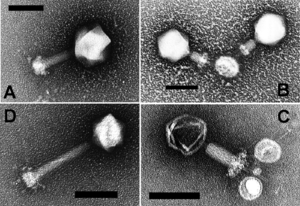Cyanophage

Electron micrograph of negative-stained Prochlorococcus myoviruses
A cyanophage is a virus that infects cyanobacteria. The name is constructed from the term phage, for a virus that targets bacteria, and cyanobacteria for the specific type of bacteria this virus uses for replication. Because of the important role of cyanobacteria as primary producers in the world's oceans, the study of their phage ecology is important toward understanding global carbon cycling.
The first cyanophage, LPP-1, was discovered in 1963.[1] Cyanophages are classified within the bacteriophage families Myoviridae (eg AS-1, N-1), Podoviridae (eg LPP-1) and Siphoviridae (eg S-1).[1]
References
External links
- the Virus Ecology Group (VEG)
- the Bacteriophage Ecology Group (BEG)
- the Tucson Marine Phage Lab (TMPL)
Further reading
- Clokie MR, Mann NH (Dec 2006). "Marine cyanophages and light". Environ Microbiol. 8 (12): 2074–82. doi:10.1111/j.1462-2920.2006.01171.x. PMID 17107549.
- Mann NH (Apr 2003). "Phages of the marine cyanobacterial picophytoplankton". FEMS Microbiol Rev. 27 (1): 17–34. doi:10.1016/S0168-6445(03)00016-0. PMID 12697340.
- Paul JH, Sullivan MB (Jun 2005). "Marine phage genomics: what have we learned?". Current Opinion in Biotechnology. 16 (3): 299–307. doi:10.1016/j.copbio.2005.03.007. PMID 15961031.
This article is issued from Wikipedia - version of the 8/20/2016. The text is available under the Creative Commons Attribution/Share Alike but additional terms may apply for the media files.